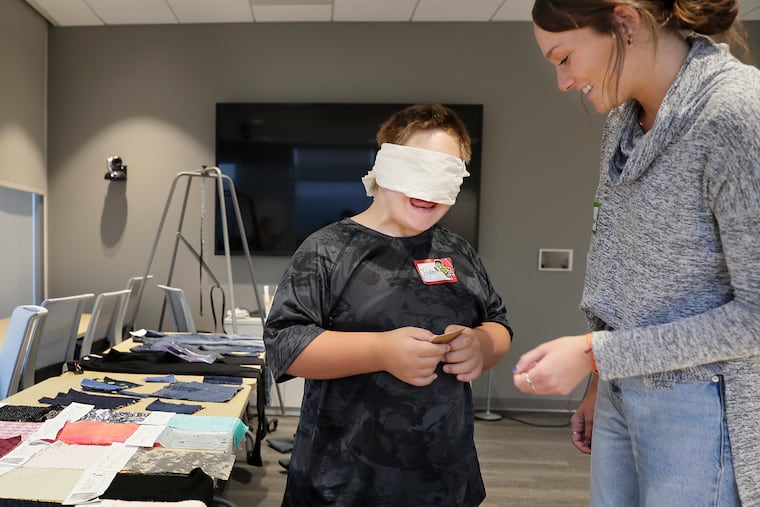For those with Down syndrome, not all clothing is accessible. These researchers want to change that.
A University of Delaware program is helping to create the first clothing sizing guide for people with Down syndrome and other disabilities.

When Jayden Niblett wakes up each morning, his mind races to remember what he is doing that day, and what he can wear to impress his friends.
The last often leads to annoyance. Jayden, 11, who has Down syndrome, struggles to find clothes that fit his unique body type and are accommodating of his motor deficits, an issue that people with physical disabilities face every day in a world where fashion is built on single-size body standards.
“It’s really frustrating for him,” said Janet Littleton, Jayden’s grandmother. “It absolutely affects his mood and how his whole day is going to go.”
People with Down have shorter limbs, rounder bodies, and common sensitivities to tags and fabrics, which make it difficult to find everyday clothes, like jeans, that fit them and feel good. Jayden would often wear women’s capri pants because they fit his waist and shorter legs. But as he has grown into a more muscular body, capris are no longer working.
Now, though, Jayden and his grandmother are working on a solution: They’re participating in a research study at the University of Delaware’s Innovation, Health and Design Lab to generate the country’s first size guide for people with Down syndrome. The lab’s mission is to provide a whole community with access to outfits that help them function with more independence and confidence.
At the end of the study, Jayden and the nearly 1,000 other participating children with Down syndrome will receive a free custom-made pair of jeans that accommodate their size and limited motor functions.
The lab, which opened in September 2018, is powered by the vision and leadership of Martha Hall, a fashion designer turned biomechanical engineer. Hall, who was born in Newark, Del., earned her undergraduate and master’s degrees from UD and then a Ph.D. in biomechanics from the school in 2018. She started her career designing cocktail dresses, but once she saw the work UD professor Cole Galloway was doing for children with motor deficits, she dedicated her work to improving minority populations’ quality of life through functional clothing.
“People think of fashion as a sort of fluffy science,” said Hall. “But I’ve always encouraged people to consider fashion as being all about self-advocacy and self-expression."
The lab started with two students working on four projects, and now has 34 students — and a wait list — with 22 projects, which address everything from inclusive apparel and athletic wear to medical devices that can increase the survival chances of premature babies. Its work centers around improving quality of life through clothing, and has been so successful that by next fall, Hall plans to launch health design as a major at the university, the first program of its kind in the country.
Some brands have tried to make accessible, sensory sensitive clothing lines, but they’re not using accurate size guides, said Hall.
“There’s not a lot of evidence for the design decisions that [some brands] are making,” said Hall. “It’s great that there are designers interested in serving the population, but you have to talk to the community and understand what the actual issue is … in order to design something that actually suits them.”
That’s where Hall’s student researchers come in. With the Down syndrome size guide and jean project, Kiersten McCormack interviews caregivers to learn their child’s specific needs. Senior Elizabeth deBruin built an “obstacle course” for kids to pick out fabrics, designs, and colors for their jeans. Sydney Solem, a senior majoring in medical diagnostics, manages the body scanner. Together, the group focuses on fashion, function, fit, fasteners, and fabric.
To generate the size chart, the lab uses a three-dimensional scanner that scans participants’ bodies and creates a 3D colored avatar with exact measurements of their size and shape. Once all participants are scanned, the company that created the machine, Human Solutions, will take the measurements, create a size guide, and sell the guide to companies, which will be able to design clothing based on accurate measurements for this population of people.
While learning to dress themselves independently is a key rite of passage for children, for those with disabilities who need assistance, it can becomes one more thing that makes them feel different from their peers.
Such is the case for Gail Hamblin, whose 7-year-old son Calvin has Down syndrome, autism, and multiple muscular, bone, and nutritional deficiencies. He needs tagless and seamless onesies that accommodate his small body frame and gastrointestinal tubes.
“I would like him to not even notice that he’s wearing clothes,” Hamblin said.
With the help of Hall and her students, Hamblin’s hope for Calvin may become a reality for him and for thousands of others like him.
Including Jayden Niblett.
“He doesn’t want to be reliant on other people" to help him dress. "He wants to be self-reliant,” said Littleton, Jayden’s grandmother. “And he’s excited to look good in what’s he’s wearing.”